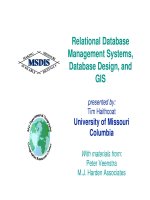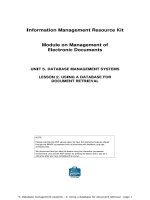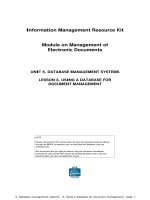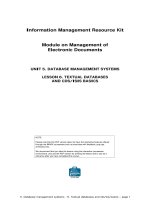01 mcgraw hil database management systems 2nd ed
Bạn đang xem bản rút gọn của tài liệu. Xem và tải ngay bản đầy đủ của tài liệu tại đây (6.43 MB, 931 trang )
CONTENTS
PREFACE xxii
Part I BASICS 1
1 INTRODUCTION TO DATABASE SYSTEMS 3
1.1 Overview 4
1.2 A Historical Perspective 5
1.3 File Systems versus a DBMS 7
1.4 Advantages of a DBMS 8
1.5 Describing and Storing Data in a DBMS 9
1.5.1 The Relational Model 10
1.5.2 Levels of Abstraction in a DBMS 11
1.5.3 Data Independence 14
1.6 Queries in a DBMS 15
1.7 Transaction Management 15
1.7.1 Concurrent Execution of Transactions 16
1.7.2 Incomplete Transactions and System Crashes 17
1.7.3 Points to Note 18
1.8 Structure of a DBMS 18
1.9 People Who Deal with Databases 20
1.10 Points to Review 21
2 THE ENTITY-RELATIONSHIP MODEL 24
2.1 Overview of Database Design 24
2.1.1 Beyond the ER Model 25
2.2 Entities, Attributes, and Entity Sets 26
2.3 Relationships and Relationship Sets 27
2.4 Additional Features of the ER Model 30
2.4.1 Key Constraints 30
2.4.2 Participation Constraints 32
2.4.3 Weak Entities 33
2.4.4 Class Hierarchies 35
2.4.5 Aggregation 37
vii
viii Database Management Systems
2.5 Conceptual Database Design With the ER Model 38
2.5.1 Entity versus Attribute 39
2.5.2 Entity versus Relationship 40
2.5.3 Binary versus Ternary Relationships * 41
2.5.4 Aggregation versus Ternary Relationships * 43
2.6 Conceptual Design for Large Enterprises * 44
2.7 Points to Review 45
3 THE RELATIONAL MODEL 51
3.1 Introduction to the Relational Model 52
3.1.1 Creating and Modifying Relations Using SQL-92 55
3.2 Integrity Constraints over Relations 56
3.2.1 Key Constraints 57
3.2.2 Foreign Key Constraints 59
3.2.3 General Constraints 61
3.3 Enforcing Integrity Constraints 62
3.4 Querying Relational Data 64
3.5 Logical Database Design: ER to Relational 66
3.5.1 Entity Sets to Tables 67
3.5.2 Relationship Sets (without Constraints) to Tables 67
3.5.3 Translating Relationship Sets with Key Constraints 69
3.5.4 Translating Relationship Sets with Participation Constraints 71
3.5.5 Translating Weak Entity Sets 73
3.5.6 Translating Class Hierarchies 74
3.5.7 Translating ER Diagrams with Aggregation 75
3.5.8 ER to Relational: Additional Examples * 76
3.6 Introduction to Views 78
3.6.1 Views, Data Independence, Security 79
3.6.2 Updates on Views 79
3.7 Destroying/Altering Tables and Views 82
3.8 Points to Review 83
Part II RELATIONAL QUERIES 89
4 RELATIONAL ALGEBRA AND CALCULUS 91
4.1 Preliminaries 91
4.2 Relational Algebra 92
4.2.1 Selection and Projection 93
4.2.2 Set Operations 94
4.2.3 Renaming 96
4.2.4 Joins 97
4.2.5 Division 99
4.2.6 More Examples of Relational Algebra Queries 100
Contents ix
4.3 Relational Calculus 106
4.3.1 Tuple Relational Calculus 107
4.3.2 Domain Relational Calculus 111
4.4 Expressive Power of Algebra and Calculus * 114
4.5 Points to Review 115
5 SQL: QUERIES, PROGRAMMING, TRIGGERS 119
5.1 About the Examples 121
5.2 The Form of a Basic SQL Query 121
5.2.1 Examples of Basic SQL Queries 126
5.2.2 Expressions and Strings in the SELECT Command 127
5.3 UNION, INTERSECT, and EXCEPT 129
5.4 Nested Queries 132
5.4.1 Introduction to Nested Queries 132
5.4.2 Correlated Nested Queries 134
5.4.3 Set-Comparison Operators 135
5.4.4 More Examples of Nested Queries 136
5.5 Aggregate Operators 138
5.5.1 The GROUP BY and HAVING Clauses 140
5.5.2 More Examples of Aggregate Queries 143
5.6 Null Values * 147
5.6.1 Comparisons Using Null Values 147
5.6.2 Logical Connectives AND, OR, and NOT 148
5.6.3 Impact on SQL Constructs 148
5.6.4 Outer Joins 149
5.6.5 Disallowing Null Values 150
5.7 Embedded SQL * 150
5.7.1 Declaring Variables and Exceptions 151
5.7.2 Embedding SQL Statements 152
5.8 Cursors * 153
5.8.1 Basic Cursor Definition and Usage 153
5.8.2 Properties of Cursors 155
5.9 Dynamic SQL * 156
5.10 ODBC and JDBC * 157
5.10.1 Architecture 158
5.10.2 An Example Using JDBC 159
5.11 Complex Integrity Constraints in SQL-92 * 161
5.11.1 Constraints over a Single Table 161
5.11.2 Domain Constraints 162
5.11.3 Assertions: ICs over Several Tables 163
5.12 Triggers and Active Databases 164
5.12.1 Examples of Triggers in SQL 165
5.13 Designing Active Databases 166
5.13.1 Why Triggers Can Be Hard to Understand 167
x Database Management Systems
5.13.2 Constraints versus Triggers 167
5.13.3 Other Uses of Triggers 168
5.14 Points to Review 168
6 QUERY-BY-EXAMPLE (QBE) 177
6.1 Introduction 177
6.2 Basic QBE Queries 178
6.2.1 Other Features: Duplicates, Ordering Answers 179
6.3 Queries over Multiple Relations 180
6.4 Negation in the Relation-Name Column 181
6.5 Aggregates 181
6.6 The Conditions Box 183
6.6.1 And/Or Queries 184
6.7 Unnamed Columns 185
6.8 Updates 185
6.8.1 Restrictions on Update Commands 187
6.9 Division and Relational Completeness * 187
6.10 Points to Review 189
Part III DATA STORAGE AND INDEXING 193
7 STORING DATA: DISKS AND FILES 195
7.1 The Memory Hierarchy 196
7.1.1 Magnetic Disks 197
7.1.2 Performance Implications of Disk Structure 199
7.2 RAID 200
7.2.1 Data Striping 200
7.2.2 Redundancy 201
7.2.3 Levels of Redundancy 203
7.2.4 Choice of RAID Levels 206
7.3 Disk Space Management 207
7.3.1 Keeping Track of Free Blocks 207
7.3.2 Using OS File Systems to Manage Disk Space 207
7.4 Buffer Manager 208
7.4.1 Buffer Replacement Policies 211
7.4.2 Buffer Management in DBMS versus OS 212
7.5 Files and Indexes 214
7.5.1 Heap Files 214
7.5.2 Introduction to Indexes 216
7.6 Page Formats * 218
7.6.1 Fixed-Length Records 218
7.6.2 Variable-Length Records 219
7.7 Record Formats * 221
Contents xi
7.7.1 Fixed-Length Records 222
7.7.2 Variable-Length Records 222
7.8 Points to Review 224
8 FILE ORGANIZATIONS AND INDEXES 230
8.1 Cost Model 231
8.2 Comparison of Three File Organizations 232
8.2.1 Heap Files 232
8.2.2 Sorted Files 233
8.2.3 Hashed Files 235
8.2.4 Choosing a File Organization 236
8.3 Overview of Indexes 237
8.3.1 Alternatives for Data Entries in an Index 238
8.4 Properties of Indexes 239
8.4.1 Clustered versus Unclustered Indexes 239
8.4.2 Dense versus Sparse Indexes 241
8.4.3 Primary and Secondary Indexes 242
8.4.4 Indexes Using Composite Search Keys 243
8.5 Index Specification in SQL-92 244
8.6 Points to Review 244
9 TREE-STRUCTURED INDEXING 247
9.1 Indexed Sequential Access Method (ISAM) 248
9.2 B+ Trees: A Dynamic Index Structure 253
9.3 Format of a Node 254
9.4 Search 255
9.5 Insert 257
9.6 Delete * 260
9.7 Duplicates * 265
9.8 B+ Trees in Practice * 266
9.8.1 Key Compression 266
9.8.2 Bulk-Loading a B+ Tree 268
9.8.3 The Order Concept 271
9.8.4 The Effect of Inserts and Deletes on Rids 272
9.9 Points to Review 272
10 HASH-BASED INDEXING 278
10.1 Static Hashing 278
10.1.1 Notation and Conventions 280
10.2 Extendible Hashing * 280
10.3 Linear Hashing * 286
10.4 Extendible Hashing versus Linear Hashing * 291
10.5 Points to Review 292
xii Database Management Systems
Part IV QUERY EVALUATION
299
11 EXTERNAL SORTING 301
11.1 A Simple Two-Way Merge Sort 302
11.2 External Merge Sort 305
11.2.1 Minimizing the Number of Runs * 308
11.3 Minimizing I/O Cost versus Number of I/Os 309
11.3.1 Blocked I/O 310
11.3.2 Double Buffering 311
11.4 Using B+ Trees for Sorting 312
11.4.1 Clustered Index 312
11.4.2 Unclustered Index 313
11.5 Points to Review 315
12 EVALUATION OF RELATIONAL OPERATORS 319
12.1 Introduction to Query Processing 320
12.1.1 Access Paths 320
12.1.2 Preliminaries: Examples and Cost Calculations 321
12.2 The Selection Operation 321
12.2.1 No Index, Unsorted Data 322
12.2.2 No Index, Sorted Data 322
12.2.3 B+ Tree Index 323
12.2.4 Hash Index, Equality Selection 324
12.3 General Selection Conditions * 325
12.3.1 CNF and Index Matching 325
12.3.2 Evaluating Selections without Disjunction 326
12.3.3 Selections with Disjunction 327
12.4 The Projection Operation 329
12.4.1 Projection Based on Sorting 329
12.4.2 Projection Based on Hashing * 330
12.4.3 Sorting versus Hashing for Projections * 332
12.4.4 Use of Indexes for Projections * 333
12.5 The Join Operation 333
12.5.1 Nested Loops Join 334
12.5.2 Sort-Merge Join * 339
12.5.3 Hash Join * 343
12.5.4 General Join Conditions * 348
12.6 The Set Operations * 349
12.6.1 Sorting for Union and Difference 349
12.6.2 Hashing for Union and Difference 350
12.7 Aggregate Operations * 350
12.7.1 Implementing Aggregation by Using an Index 351
12.8 The Impact of Buffering * 352
Contents xiii
12.9 Points to Review 353
13 INTRODUCTION TO QUERY OPTIMIZATION 359
13.1 Overview of Relational Query Optimization 360
13.1.1 Query Evaluation Plans 361
13.1.2 Pipelined Evaluation 362
13.1.3 The Iterator Interface for Operators and Access Methods 363
13.1.4 The System R Optimizer 364
13.2 System Catalog in a Relational DBMS 365
13.2.1 Information Stored in the System Catalog 365
13.3 Alternative Plans: A Motivating Example 368
13.3.1 Pushing Selections 368
13.3.2 Using Indexes 370
13.4 Points to Review 373
14 A TYPICAL RELATIONAL QUERY OPTIMIZER 374
14.1 Translating SQL Queries into Algebra 375
14.1.1 Decomposition of a Query into Blocks 375
14.1.2 A Query Block as a Relational Algebra Expression 376
14.2 Estimating the Cost of a Plan 378
14.2.1 Estimating Result Sizes 378
14.3 Relational Algebra Equivalences 383
14.3.1 Selections 383
14.3.2 Projections 384
14.3.3 Cross-Products and Joins 384
14.3.4 Selects, Projects, and Joins 385
14.3.5 Other Equivalences 387
14.4 Enumeration of Alternative Plans 387
14.4.1 Single-Relation Queries 387
14.4.2 Multiple-Relation Queries 392
14.5 Nested Subqueries 399
14.6 Other Approaches to Query Optimization 402
14.7 Points to Review 403
Part V DATABASE DESIGN 415
15 SCHEMA REFINEMENT AND NORMAL FORMS 417
15.1 Introduction to Schema Refinement 418
15.1.1 Problems Caused by Redundancy 418
15.1.2 Use of Decompositions 420
15.1.3 Problems Related to Decomposition 421
15.2 Functional Dependencies 422
15.3 Examples Motivating Schema Refinement 423
xiv Database Management Systems
15.3.1 Constraints on an Entity Set 423
15.3.2 Constraints on a Relationship Set 424
15.3.3 Identifying Attributes of Entities 424
15.3.4 Identifying Entity Sets 426
15.4 Reasoning about Functional Dependencies 427
15.4.1 Closure of a Set of FDs 427
15.4.2 Attribute Closure 429
15.5 Normal Forms 430
15.5.1 Boyce-Codd Normal Form 430
15.5.2 Third Normal Form 432
15.6 Decompositions 434
15.6.1 Lossless-Join Decomposition 435
15.6.2 Dependency-Preserving Decomposition 436
15.7 Normalization 438
15.7.1 Decomposition into BCNF 438
15.7.2 Decomposition into 3NF * 440
15.8 Other Kinds of Dependencies * 444
15.8.1 Multivalued Dependencies 445
15.8.2 Fourth Normal Form 447
15.8.3 Join Dependencies 449
15.8.4 Fifth Normal Form 449
15.8.5 Inclusion Dependencies 449
15.9 Points to Review 450
16 PHYSICAL DATABASE DESIGN AND TUNING 457
16.1 Introduction to Physical Database Design 458
16.1.1 Database Workloads 458
16.1.2 Physical Design and Tuning Decisions 459
16.1.3 Need for Database Tuning 460
16.2 Guidelines for Index Selection 460
16.3 Basic Examples of Index Selection 463
16.4 Clustering and Indexing * 465
16.4.1 Co-clustering Two Relations 468
16.5 Indexes on Multiple-Attribute Search Keys * 470
16.6 Indexes that Enable Index-Only Plans * 471
16.7 Overview of Database Tuning 474
16.7.1 Tuning Indexes 474
16.7.2 Tuning the Conceptual Schema 475
16.7.3 Tuning Queries and Views 476
16.8 Choices in Tuning the Conceptual Schema * 477
16.8.1 Settling for a Weaker Normal Form 478
16.8.2 Denormalization 478
16.8.3 Choice of Decompositions 479
16.8.4 Vertical Decomposition 480
Contents xv
16.8.5 Horizontal Decomposition 481
16.9 Choices in Tuning Queries and Views * 482
16.10 Impact of Concurrency * 484
16.11 DBMS Benchmarking * 485
16.11.1 Well-Known DBMS Benchmarks 486
16.11.2 Using a Benchmark 486
16.12 Points to Review 487
17 SECURITY 497
17.1 Introduction to Database Security 497
17.2 Access Control 498
17.3 Discretionary Access Control 499
17.3.1 Grant and Revoke on Views and Integrity Constraints * 506
17.4 Mandatory Access Control * 508
17.4.1 Multilevel Relations and Polyinstantiation 510
17.4.2 Covert Channels, DoD Security Levels 511
17.5 Additional Issues Related to Security * 512
17.5.1 Role of the Database Administrator 512
17.5.2 Security in Statistical Databases 513
17.5.3 Encryption 514
17.6 Points to Review 517
Part VI TRANSACTION MANAGEMENT 521
18 TRANSACTION MANAGEMENT OVERVIEW 523
18.1 The Concept of a Transaction 523
18.1.1 Consistency and Isolation 525
18.1.2 Atomicity and Durability 525
18.2 Transactions and Schedules 526
18.3 Concurrent Execution of Transactions 527
18.3.1 Motivation for Concurrent Execution 527
18.3.2 Serializability 528
18.3.3 Some Anomalies Associated with Interleaved Execution 528
18.3.4 Schedules Involving Aborted Transactions 531
18.4 Lock-Based Concurrency Control 532
18.4.1 Strict Two-Phase Locking (Strict 2PL) 532
18.5 Introduction to Crash Recovery 533
18.5.1 Stealing Frames and Forcing Pages 535
18.5.2 Recovery-Related Steps during Normal Execution 536
18.5.3 Overview of ARIES 537
18.6 Points to Review 537
19 CONCURRENCY CONTROL 540
xvi Database Management Systems
19.1 Lock-Based Concurrency Control Revisited 540
19.1.1 2PL, Serializability, and Recoverability 540
19.1.2 View Serializability 543
19.2 Lock Management 543
19.2.1 Implementing Lock and Unlock Requests 544
19.2.2 Deadlocks 546
19.2.3 Performance of Lock-Based Concurrency Control 548
19.3 Specialized Locking Techniques 549
19.3.1 Dynamic Databases and the Phantom Problem 550
19.3.2 Concurrency Control in B+ Trees 551
19.3.3 Multiple-Granularity Locking 554
19.4 Transaction Support in SQL-92 * 555
19.4.1 Transaction Characteristics 556
19.4.2 Transactions and Constraints 558
19.5 Concurrency Control without Locking 559
19.5.1 Optimistic Concurrency Control 559
19.5.2 Timestamp-Based Concurrency Control 561
19.5.3 Multiversion Concurrency Control 563
19.6 Points to Review 564
20 CRASH RECOVERY 571
20.1 Introduction to ARIES 571
20.1.1 The Log 573
20.1.2 Other Recovery-Related Data Structures 576
20.1.3 The Write-Ahead Log Protocol 577
20.1.4 Checkpointing 578
20.2 Recovering from a System Crash 578
20.2.1 Analysis Phase 579
20.2.2 Redo Phase 581
20.2.3 Undo Phase 583
20.3 Media Recovery 586
20.4 Other Algorithms and Interaction with Concurrency Control 587
20.5 Points to Review 588
Part VII ADVANCED TOPICS 595
21 PARALLEL AND DISTRIBUTED DATABASES 597
21.1 Architectures for Parallel Databases 598
21.2 Parallel Query Evaluation 600
21.2.1 Data Partitioning 601
21.2.2 Parallelizing Sequential Operator Evaluation Code 601
21.3 Parallelizing Individual Operations 602
21.3.1 Bulk Loading and Scanning 602
Contents xvii
21.3.2 Sorting 602
21.3.3 Joins 603
21.4 Parallel Query Optimization 606
21.5 Introduction to Distributed Databases 607
21.5.1 Types of Distributed Databases 607
21.6 Distributed DBMS Architectures 608
21.6.1 Client-Server Systems 608
21.6.2 Collaborating Server Systems 609
21.6.3 Middleware Systems 609
21.7 Storing Data in a Distributed DBMS 610
21.7.1 Fragmentation 610
21.7.2 Replication 611
21.8 Distributed Catalog Management 611
21.8.1 Naming Objects 612
21.8.2 Catalog Structure 612
21.8.3 Distributed Data Independence 613
21.9 Distributed Query Processing 614
21.9.1 Nonjoin Queries in a Distributed DBMS 614
21.9.2 Joins in a Distributed DBMS 615
21.9.3 Cost-Based Query Optimization 619
21.10 Updating Distributed Data 619
21.10.1 Synchronous Replication 620
21.10.2 Asynchronous Replication 621
21.11 Introduction to Distributed Transactions 624
21.12 Distributed Concurrency Control 625
21.12.1 Distributed Deadlock 625
21.13 Distributed Recovery 627
21.13.1 Normal Execution and Commit Protocols 628
21.13.2 Restart after a Failure 629
21.13.3 Two-Phase Commit Revisited 630
21.13.4 Three-Phase Commit 632
21.14 Points to Review 632
22 INTERNET DATABASES 642
22.1 The World Wide Web 643
22.1.1 Introduction to HTML 643
22.1.2 Databases and the Web 645
22.2 Architecture 645
22.2.1 Application Servers and Server-Side Java 647
22.3 Beyond HTML 651
22.3.1 Introduction to XML 652
22.3.2 XML DTDs 654
22.3.3 Domain-Specific DTDs 657
22.3.4 XML-QL: Querying XML Data 659
xviii Database Management Systems
22.3.5 The Semistructured Data Model 661
22.3.6 Implementation Issues for Semistructured Data 663
22.4 Indexing for Text Search 663
22.4.1 Inverted Files 665
22.4.2 Signature Files 666
22.5 Ranked Keyword Searches on the Web 667
22.5.1 An Algorithm for Ranking Web Pages 668
22.6 Points to Review 671
23 DECISION SUPPORT 677
23.1 Introduction to Decision Support 678
23.2 Data Warehousing 679
23.2.1 Creating and Maintaining a Warehouse 680
23.3 OLAP 682
23.3.1 Multidimensional Data Model 682
23.3.2 OLAP Queries 685
23.3.3 Database Design for OLAP 689
23.4 Implementation Techniques for OLAP 690
23.4.1 Bitmap Indexes 691
23.4.2 Join Indexes 692
23.4.3 File Organizations 693
23.4.4 Additional OLAP Implementation Issues 693
23.5 Views and Decision Support 694
23.5.1 Views, OLAP, and Warehousing 694
23.5.2 Query Modification 695
23.5.3 View Materialization versus Computing on Demand 696
23.5.4 Issues in View Materialization 698
23.6 Finding Answers Quickly 699
23.6.1 Top N Queries 700
23.6.2 Online Aggregation 701
23.7 Points to Review 702
24 DATA MINING 707
24.1 Introduction to Data Mining 707
24.2 Counting Co-occurrences 708
24.2.1 Frequent Itemsets 709
24.2.2 Iceberg Queries 711
24.3 Mining for Rules 713
24.3.1 Association Rules 714
24.3.2 An Algorithm for Finding Association Rules 714
24.3.3 Association Rules and ISA Hierarchies 715
24.3.4 Generalized Association Rules 716
24.3.5 Sequential Patterns 717
Contents xix
24.3.6 The Use of Association Rules for Prediction 718
24.3.7 Bayesian Networks 719
24.3.8 Classification and Regression Rules 720
24.4 Tree-Structured Rules 722
24.4.1 Decision Trees 723
24.4.2 An Algorithm to Build Decision Trees 725
24.5 Clustering 726
24.5.1 A Clustering Algorithm 728
24.6 Similarity Search over Sequences 729
24.6.1 An Algorithm to Find Similar Sequences 730
24.7 Additional Data Mining Tasks 731
24.8 Points to Review 732
25 OBJECT-DATABASE SYSTEMS 736
25.1 Motivating Example 737
25.1.1 New Data Types 738
25.1.2 Manipulating the New Kinds of Data 739
25.2 User-Defined Abstract Data Types 742
25.2.1 Defining Methods of an ADT 743
25.3 Structured Types 744
25.3.1 Manipulating Data of Structured Types 745
25.4 Objects, Object Identity, and Reference Types 748
25.4.1 Notions of Equality 749
25.4.2 Dereferencing Reference Types 750
25.5 Inheritance 750
25.5.1 Defining Types with Inheritance 751
25.5.2 Binding of Methods 751
25.5.3 Collection Hierarchies, Type Extents, and Queries 752
25.6 Database Design for an ORDBMS 753
25.6.1 Structured Types and ADTs 753
25.6.2 Object Identity 756
25.6.3 Extending the ER Model 757
25.6.4 Using Nested Collections 758
25.7 New Challenges in Implementing an ORDBMS 759
25.7.1 Storage and Access Methods 760
25.7.2 Query Processing 761
25.7.3 Query Optimization 763
25.8 OODBMS 765
25.8.1 The ODMG Data Model and ODL 765
25.8.2 OQL 768
25.9 Comparing RDBMS with OODBMS and ORDBMS 769
25.9.1 RDBMS versus ORDBMS 769
25.9.2 OODBMS versus ORDBMS: Similarities 770
25.9.3 OODBMS versus ORDBMS: Differences 770
xx Database Management Systems
25.10 Points to Review 771
26 SPATIAL DATA MANAGEMENT 777
26.1 Types of Spatial Data and Queries 777
26.2 Applications Involving Spatial Data 779
26.3 Introduction to Spatial Indexes 781
26.3.1 Overview of Proposed Index Structures 782
26.4 Indexing Based on Space-Filling Curves 783
26.4.1 Region Quad Trees and Z-Ordering: Region Data 784
26.4.2 Spatial Queries Using Z-Ordering 785
26.5 Grid Files 786
26.5.1 Adapting Grid Files to Handle Regions 789
26.6 R Trees: Point and Region Data 789
26.6.1 Queries 790
26.6.2 Insert and Delete Operations 792
26.6.3 Concurrency Control 793
26.6.4 Generalized Search Trees 794
26.7 Issues in High-Dimensional Indexing 795
26.8 Points to Review 795
27 DEDUCTIVE DATABASES 799
27.1 Introduction to Recursive Queries 800
27.1.1 Datalog 801
27.2 Theoretical Foundations 803
27.2.1 Least Model Semantics 804
27.2.2 Safe Datalog Programs 805
27.2.3 The Fixpoint Operator 806
27.2.4 Least Model = Least Fixpoint 807
27.3 Recursive Queries with Negation 808
27.3.1 Range-Restriction and Negation 809
27.3.2 Stratification 809
27.3.3 Aggregate Operations 812
27.4 Efficient Evaluation of Recursive Queries 813
27.4.1 Fixpoint Evaluation without Repeated Inferences 814
27.4.2 Pushing Selections to Avoid Irrelevant Inferences 816
27.5 Points to Review 818
28 ADDITIONAL TOPICS 822
28.1 Advanced Transaction Processing 822
28.1.1 Transaction Processing Monitors 822
28.1.2 New Transaction Models 823
28.1.3 Real-Time DBMSs 824
28.2 Integrated Access to Multiple Data Sources 824
Contents xxi
28.3 Mobile Databases 825
28.4 Main Memory Databases 825
28.5 Multimedia Databases 826
28.6 Geographic Information Systems 827
28.7 Temporal and Sequence Databases 828
28.8 Information Visualization 829
28.9 Summary 829
A DATABASE DESIGN CASE STUDY: THE INTERNET
SHOP
831
A.1 Requirements Analysis 831
A.2 Conceptual Design 832
A.3 Logical Database Design 832
A.4 Schema Refinement 835
A.5 Physical Database Design 836
A.5.1 Tuning the Database 838
A.6 Security 838
A.7 Application Layers 840
B THE MINIBASE SOFTWARE 842
B.1 What’s Available 842
B.2 Overview of Minibase Assignments 843
B.2.1 Overview of Programming Projects 843
B.2.2 Overview of Nonprogramming Assignments 844
B.3 Acknowledgments 845
REFERENCES 847
SUBJECT INDEX 879
AUTHOR INDEX 896
PREFACE
The advantage of doing one’s praising for oneself is that one can lay it on so thick
and exactly in the right places.
—Samuel Butler
Database management systems have become ubiquitous as a fundamental tool for man-
aging information, and a course on the principles and practice of database systems is
now an integral part of computer science curricula. This book covers the fundamentals
of modern database management systems, in particular relational database systems.
It is intended as a text for an introductory database course for undergraduates, and
we have attempted to present the material in a clear, simple style.
A quantitative approach is used throughout and detailed examples abound. An exten-
sive set of exercises (for which solutions are available online to instructors) accompanies
each chapter and reinforces students’ ability to apply the concepts to real problems.
The book contains enough material to support a second course, ideally supplemented
by selected research papers. It can be used, with the accompanying software and SQL
programming assignments, in two distinct kinds of introductory courses:
1. A course that aims to present the principles of database systems, with a practical
focus but without any implementation assignments. The SQL programming as-
signments are a useful supplement for such a course. The supplementary Minibase
software can be used to create exercises and experiments with no programming.
2. A course that has a strong systems emphasis and assumes that students have
good programming skills in C and C++. In this case the software can be used
as the basis for projects in which students are asked to implement various parts
of a relational DBMS. Several central modules in the project software (e.g., heap
files, buffer manager, B+ trees, hash indexes, various join methods, concurrency
control, and recovery algorithms) are described in sufficient detail in the text to
enable students to implement them, given the (C++) class interfaces.
Many instructors will no doubt teach a course that falls between these two extremes.
xxii
Preface xxiii
Choice of Topics
The choice of material has been influenced by these considerations:
To concentrate on issues central to the design, tuning, and implementation of rela-
tional database applications. However, many of the issues discussed (e.g., buffering
and access methods) are not specific to relational systems, and additional topics
such as decision support and object-database systems are covered in later chapters.
To provide adequate coverage of implementation topics to support a concurrent
laboratory section or course project. For example, implementation of relational
operations has been covered in more detail than is necessary in a first course.
However, the variety of alternative implementation techniques permits a wide
choice of project assignments. An instructor who wishes to assign implementation
of sort-merge join might cover that topic in depth, whereas another might choose
to emphasize index nested loops join.
To provide in-depth coverage of the state of the art in currently available commer-
cial systems, rather than a broad coverage of several alternatives. For example,
we discuss the relational data model, B+ trees, SQL, System R style query op-
timization, lock-based concurrency control, the ARIES recovery algorithm, the
two-phase commit protocol, asynchronous replication in distributed databases,
and object-relational DBMSs in detail, with numerous illustrative examples. This
is made possible by omitting or briefly covering some related topics such as the
hierarchical and network models, B tree variants, Quel, semantic query optimiza-
tion, view serializability, the shadow-page recovery algorithm, and the three-phase
commit protocol.
The same preference for in-depth coverage of selected topics governed our choice
of topics for chapters on advanced material. Instead of covering a broad range of
topics briefly, we have chosen topics that we believe to be practically important
and at the cutting edge of current thinking in database systems, and we have
coveredthemindepth.
New in the Second Edition
Based on extensive user surveys and feedback, we have refined the book’s organization.
The major change is the early introduction of the ER model, together with a discussion
of conceptual database design. As in the first edition, we introduce SQL-92’s data
definition features together with the relational model (in Chapter 3), and whenever
appropriate, relational model concepts (e.g., definition of a relation, updates, views, ER
to relational mapping) are illustrated and discussed in the context of SQL. Of course,
we maintain a careful separation between the concepts and their SQL realization. The
material on data storage, file organization, and indexes has been moved back, and the
xxiv Database Management Systems
material on relational queries has been moved forward. Nonetheless, the two parts
(storage and organization vs. queries) can still be taught in either order based on the
instructor’s preferences.
In order to facilitate brief coverage in a first course, the second edition contains overview
chapters on transaction processing and query optimization. Most chapters have been
revised extensively, and additional explanations and figures have been added in many
places. For example, the chapters on query languages now contain a uniform numbering
of all queries to facilitate comparisons of the same query (in algebra, calculus, and
SQL), and the results of several queries are shown in figures. JDBC and ODBC
coverage has been added to the SQL query chapter and SQL:1999 features are discussed
both in this chapter and the chapter on object-relational databases. A discussion of
RAID has been added to Chapter 7. We have added a new database design case study,
illustrating the entire design cycle, as an appendix.
Two new pedagogical features have been introduced. First, ‘floating boxes’ provide ad-
ditional perspective and relate the concepts to real systems, while keeping the main dis-
cussion free of product-specific details. Second, each chapter concludes with a ‘Points
to Review’ section that summarizes the main ideas introduced in the chapter and
includes pointers to the sections where they are discussed.
For use in a second course, many advanced chapters from the first edition have been
extended or split into multiple chapters to provide thorough coverage of current top-
ics. In particular, new material has been added to the chapters on decision support,
deductive databases, and object databases. New chapters on Internet databases, data
mining, and spatial databases have been added, greatly expanding the coverage of
these topics.
The material can be divided into roughly seven parts, as indicated in Figure 0.1, which
also shows the dependencies between chapters. An arrow from Chapter I to Chapter J
means that I depends on material in J. The broken arrows indicate a weak dependency,
which can be ignored at the instructor’s discretion. It is recommended that Part I be
covered first, followed by Part II and Part III (in either order). Other than these three
parts, dependencies across parts are minimal.
Order of Presentation
The book’s modular organization offers instructors a variety of choices. For exam-
ple, some instructors will want to cover SQL and get students to use a relational
database, before discussing file organizations or indexing; they should cover Part II
before Part III. In fact, in a course that emphasizes concepts and SQL, many of the
implementation-oriented chapters might be skipped. On the other hand, instructors
assigning implementation projects based on file organizations may want to cover Part
Preface xxv
Introduction,
2
ER Model
Conceptual Design
1
QBE
5
4
Relational Algebra
and Calculus
6
7
8
Introduction to
File Organizations
Hash Indexes
10
Tree Indexes
9
II
III
I
Schema Refinement,
V
16 17
Database
Security
Physical DB
Design, Tuning
15
Transaction Mgmt
VI
19 20
Concurrency
18
Overview
Control
Crash
Recovery
13
Introduction to
11
External Sorting
14
Relational Optimizer
A Typical
IV
3
Relational Model
SQL DDL
VII
Parallel and
Distributed DBs
21
22
FDs, Normalization
Evaluation of
Relational Operators
12
Query Optimization
Data Storage
Internet
Databases
Decision
23 24
Object-Database
Systems
25
Databases
Spatial
26
Additional
Topics
2827
Mining
Data
Support
Deductive
Databases
SQL Queries, etc.
Figure 0.1 Chapter Organization and Dependencies
III early to space assignments. As another example, it is not necessary to cover all the
alternatives for a given operator (e.g., various techniques for joins) in Chapter 12 in
order to cover later related material (e.g., on optimization or tuning) adequately. The
database design case study in the appendix can be discussed concurrently with the
appropriate design chapters, or it can be discussed after all design topics have been
covered, as a review.
Several section headings contain an asterisk. This symbol does not necessarily indicate
a higher level of difficulty. Rather, omitting all asterisked sections leaves about the
right amount of material in Chapters 1
–18, possibly omitting Chapters 6, 10, and 14,
for a broad introductory one-quarter or one-semester course (depending on the depth
at which the remaining material is discussed and the nature of the course assignments).
xxvi Database Management Systems
The book can be used in several kinds of introductory or second courses by choosing
topics appropriately, or in a two-course sequence by supplementing the material with
some advanced readings in the second course. Examples of appropriate introductory
courses include courses on file organizations and introduction to database management
systems, especially if the course focuses on relational database design or implementa-
tion. Advanced courses can be built around the later chapters, which contain detailed
bibliographies with ample pointers for further study.
Supplementary Material
Each chapter contains several exercises designed to test and expand the reader’s un-
derstanding of the material. Students can obtain solutions to odd-numbered chapter
exercises and a set of lecture slides for each chapter through the Web in Postscript and
Adobe PDF formats.
The following material is available online to instructors:
1. Lecture slides for all chapters in MS Powerpoint, Postscript, and PDF formats.
2. Solutions to all chapter exercises.
3. SQL queries and programming assignments with solutions. (This is new for the
second edition.)
4. Supplementary project software (Minibase) with sample assignments and solu-
tions, as described in Appendix B. The text itself does not refer to the project
software, however, and can be used independently in a course that presents the
principles of database management systems from a practical perspective, but with-
out a project component.
The supplementary material on SQL is new for the second edition. The remaining
material has been extensively revised from the first edition versions.
For More Information
The home page for this book is at URL:
/>˜ dbbook
This page is frequently updated and contains a link to all known errors in the book, the
accompanying slides, and the supplements. Instructors should visit this site periodically
or register at this site to be notified of important changes by email.
Preface xxvii
Acknowledgments
This book grew out of lecture notes for CS564, the introductory (senior/graduate level)
database course at UW-Madison. David DeWitt developed this course and the Minirel
project, in which students wrote several well-chosen parts of a relational DBMS. My
thinking about this material was shaped by teaching CS564, and Minirel was the
inspiration for Minibase, which is more comprehensive (e.g., it has a query optimizer
and includes visualization software) but tries to retain the spirit of Minirel. Mike Carey
and I jointly designed much of Minibase. My lecture notes (and in turn this book)
were influenced by Mike’s lecture notes and by Yannis Ioannidis’s lecture slides.
Joe Hellerstein used the beta edition of the book at Berkeley and provided invaluable
feedback, assistance on slides, and hilarious quotes. Writing the chapter on object-
database systems with Joe was a lot of fun.
C. Mohan provided invaluable assistance, patiently answering a number of questions
about implementation techniques used in various commercial systems, in particular in-
dexing, concurrency control, and recovery algorithms. Moshe Zloof answered numerous
questions about QBE semantics and commercial systems based on QBE. Ron Fagin,
Krishna Kulkarni, Len Shapiro, Jim Melton, Dennis Shasha, and Dirk Van Gucht re-
viewed the book and provided detailed feedback, greatly improving the content and
presentation. Michael Goldweber at Beloit College, Matthew Haines at Wyoming,
Michael Kifer at SUNY StonyBrook, Jeff Naughton at Wisconsin, Praveen Seshadri at
Cornell, and Stan Zdonik at Brown also used the beta edition in their database courses
and offered feedback and bug reports. In particular, Michael Kifer pointed out an er-
ror in the (old) algorithm for computing a minimal cover and suggested covering some
SQL features in Chapter 2 to improve modularity. Gio Wiederhold’s bibliography,
converted to Latex format by S. Sudarshan, and Michael Ley’s online bibliography on
databases and logic programming were a great help while compiling the chapter bibli-
ographies. Shaun Flisakowski and Uri Shaft helped me frequently in my never-ending
battles with Latex.
I owe a special thanks to the many, many students who have contributed to the Mini-
base software. Emmanuel Ackaouy, Jim Pruyne, Lee Schumacher, and Michael Lee
worked with me when I developed the first version of Minibase (much of which was
subsequently discarded, but which influenced the next version). Emmanuel Ackaouy
and Bryan So were my TAs when I taught CS564 using this version and went well be-
yond the limits of a TAship in their efforts to refine the project. Paul Aoki struggled
with a version of Minibase and offered lots of useful comments as a TA at Berkeley. An
entire class of CS764 students (our graduate database course) developed much of the
current version of Minibase in a large class project that was led and coordinated by
Mike Carey and me. Amit Shukla and Michael Lee were my TAs when I first taught
CS564 using this version of Minibase and developed the software further.
xxviii Database Management Systems
Several students worked with me on independent projects, over a long period of time,
to develop Minibase components. These include visualization packages for the buffer
manager and B+ trees (Huseyin Bektas, Harry Stavropoulos, and Weiqing Huang); a
query optimizer and visualizer (Stephen Harris, Michael Lee, and Donko Donjerkovic);
an ER diagram tool based on the Opossum schema editor (Eben Haber); and a GUI-
based tool for normalization (Andrew Prock and Andy Therber). In addition, Bill
Kimmel worked to integrate and fix a large body of code (storage manager, buffer
manager, files and access methods, relational operators, and the query plan executor)
produced by the CS764 class project. Ranjani Ramamurty considerably extended
Bill’s work on cleaning up and integrating the various modules. Luke Blanshard, Uri
Shaft, and Shaun Flisakowski worked on putting together the release version of the
code and developed test suites and exercises based on the Minibase software. Krishna
Kunchithapadam tested the optimizer and developed part of the Minibase GUI.
Clearly, the Minibase software would not exist without the contributions of a great
many talented people. With this software available freely in the public domain, I hope
that more instructors will be able to teach a systems-oriented database course with a
blend of implementation and experimentation to complement the lecture material.
I’d like to thank the many students who helped in developing and checking the solu-
tions to the exercises and provided useful feedback on draft versions of the book. In
alphabetical order: X. Bao, S. Biao, M. Chakrabarti, C. Chan, W. Chen, N. Cheung,
D. Colwell, C. Fritz, V. Ganti, J. Gehrke, G. Glass, V. Gopalakrishnan, M. Higgins, T.
Jasmin, M. Krishnaprasad, Y. Lin, C. Liu, M. Lusignan, H. Modi, S. Narayanan, D.
Randolph, A. Ranganathan, J. Reminga, A. Therber, M. Thomas, Q. Wang, R. Wang,
Z. Wang, and J. Yuan. Arcady Grenader, James Harrington, and Martin Reames at
Wisconsin and Nina Tang at Berkeley provided especially detailed feedback.
Charlie Fischer, Avi Silberschatz, and Jeff Ullman gave me invaluable advice on work-
ing with a publisher. My editors at McGraw-Hill, Betsy Jones and Eric Munson,
obtained extensive reviews and guided this book in its early stages. Emily Gray and
Brad Kosirog were there whenever problems cropped up. At Wisconsin, Ginny Werner
really helped me to stay on top of things.
Finally, this book was a thief of time, and in many ways it was harder on my family
than on me. My sons expressed themselves forthrightly. From my (then) five-year-
old, Ketan: “Dad, stop working on that silly book. You don’t have any time for
me.” Two-year-old Vivek: “You working boook? No no no come play basketball me!”
All the seasons of their discontent were visited upon my wife, and Apu nonetheless
cheerfully kept the family going in its usual chaotic, happy way all the many evenings
and weekends I was wrapped up in this book. (Not to mention the days when I was
wrapped up in being a faculty member!) As in all things, I can trace my parents’ hand
in much of this; my father, with his love of learning, and my mother, with her love
of us, shaped me. My brother Kartik’s contributions to this book consisted chiefly of
Preface xxix
phone calls in which he kept me from working, but if I don’t acknowledge him, he’s
liable to be annoyed. I’d like to thank my family for being there and giving meaning
to everything I do. (There! I knew I’d find a legitimate reason to thank Kartik.)
Acknowledgments for the Second Edition
Emily Gray and Betsy Jones at McGraw-Hill obtained extensive reviews and provided
guidance and support as we prepared the second edition. Jonathan Goldstein helped
with the bibliography for spatial databases. The following reviewers provided valuable
feedback on content and organization: Liming Cai at Ohio University, Costas Tsat-
soulis at University of Kansas, Kwok-Bun Yue at University of Houston, Clear Lake,
William Grosky at Wayne State University, Sang H. Son at University of Virginia,
James M. Slack at Minnesota State University, Mankato, Herman Balsters at Uni-
versity of Twente, Netherlands, Karen C. Davis at University of Cincinnati, Joachim
Hammer at University of Florida, Fred Petry at Tulane University, Gregory Speegle
at Baylor University, Salih Yurttas at Texas A&M University, and David Chao at San
Francisco State University.
A number of people reported bugs in the first edition. In particular, we wish to thank
the following: Joseph Albert at Portland State University, Han-yin Chen at University
of Wisconsin, Lois Delcambre at Oregon Graduate Institute, Maggie Eich at South-
ern Methodist University, Raj Gopalan at Curtin University of Technology, Davood
Rafiei at University of Toronto, Michael Schrefl at University of South Australia, Alex
Thomasian at University of Connecticut, and Scott Vandenberg at Siena College.
A special thanks to the many people who answered a detailed survey about how com-
mercial systems support various features: At IBM, Mike Carey, Bruce Lindsay, C.
Mohan, and James Teng; at Informix, M. Muralikrishna and Michael Ubell; at Mi-
crosoft, David Campbell, Goetz Graefe, and Peter Spiro; at Oracle, Hakan Jacobsson,
Jonathan D. Klein, Muralidhar Krishnaprasad, and M. Ziauddin; and at Sybase, Marc
Chanliau, Lucien Dimino, Sangeeta Doraiswamy, Hanuma Kodavalla, Roger MacNicol,
and Tirumanjanam Rengarajan.
After reading about himself in the acknowledgment to the first edition, Ketan (now 8)
had a simple question: “How come you didn’t dedicate the book to us? Why mom?”
Ketan, I took care of this inexplicable oversight. Vivek (now 5) was more concerned
about the extent of his fame: “Daddy, is my name in evvy copy of your book? Do
they have it in evvy compooter science department in the world?” Vivek, I hope so.
Finally, this revision would not have made it without Apu’s and Keiko’s support.
PARTI
BASICS









